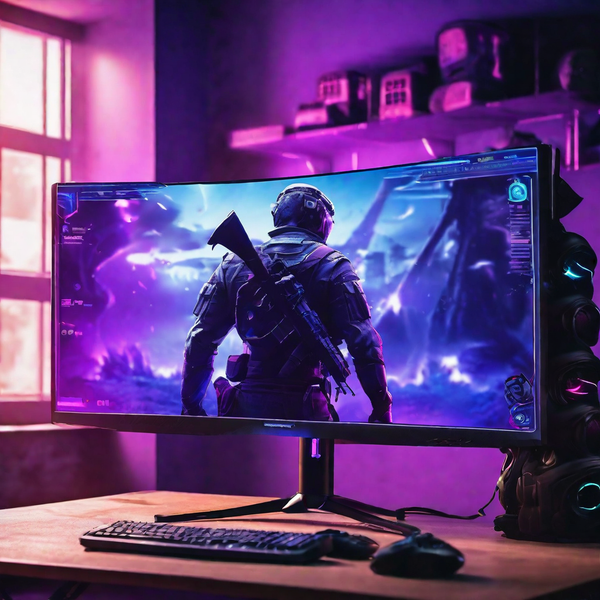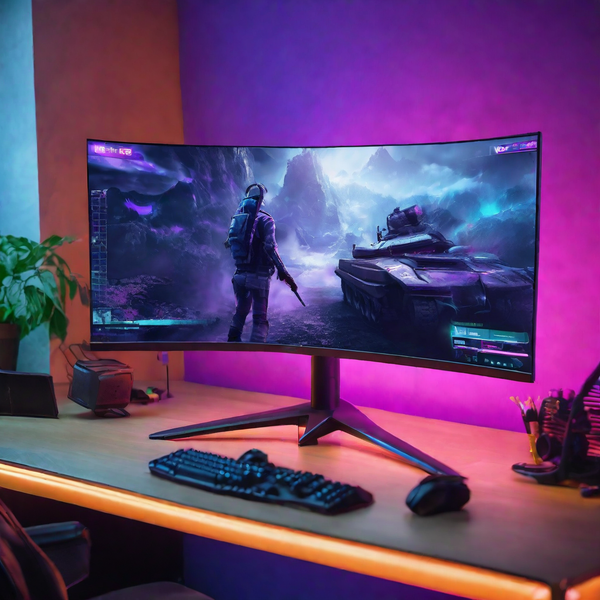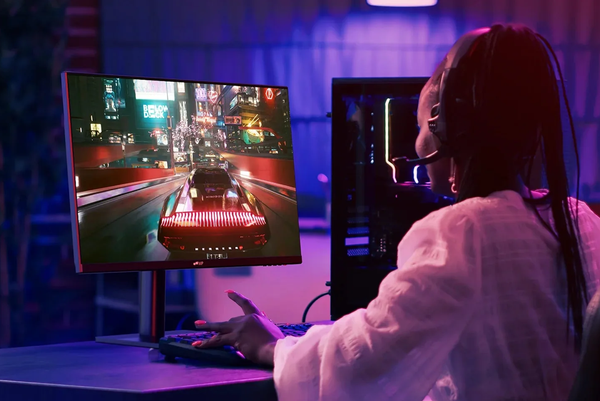When two screens "crash" into each other because the monitors have a different refresh rate, it's known as screen tearing. It occurs when the devices can’t keep up with the data sent from the graphics card, causing distortion. Screen tearing is easy to spot as it causes a cut or misalignment to appear in the display.
Similarly, when gameplay interruption (like a pause or freeze) occurs, it’s known as a game stutter. Naturally, this impacts the gaming experience due to lag, leading to less enjoyable gameplay. Game stuttering can manifest as brief pauses, decreased frame rates, and inconsistent performance.
Several factors—such as inadequate hardware or software, network issues, and problematic game optimization—cause problems like these. This is where technologies like G-Sync and FreeSync come into the picture. These display technologies support gameplay by synchronizing display variables or high refresh rates to avoid distortions, stuttering, and pauses, maintaining the fun gaming experience.
What Is V-Sync?
Vertical synchronization, or V-Sync, is a display technology initially designed to help prevent screen tearing, a distortion caused when screens "crash" into each other. V-Sync prevents this by imposing a cap on the frames per second (FPS) demanded by an application. Simply put, it recognizes the refresh rates of the monitor(s) and adjusts the image processing speeds.
While V-Sync can be used when users play modern video games, it works best with legacy games. This is because the technology slows down the frame rate output from the graphics cards to match the legacy standards.
To explain this better, let’s understand how the average computer game operates. A computer game works at 60 FPS, but high-end games may operate at 120 FPS or greater. As a result, the monitor should have a refresh rate of 120Hz to 165Hz to perform optimally. However, V-Sync is only useful when the graphics card produces a high FPS rate and the display only supports a 60Hz refresh rate, a common speed in legacy equipment and non-gaming displays.
As a result, V-Sync works well with low-end or legacy devices and degrades the performance of high-end graphics cards.
The Emergence of Adaptive Sync Technologies
Users and developers realized that although V-Sync worked well with legacy monitors, it often prevented modern graphics cards from operating at their peak. As a result, manufacturers developed special display technologies with refresh rates as high as 144Hz, 165Hz, and 240Hz. This also led to the emergence of other technologies, such as FreeSync and G-Sync.
FreeSync was released in 2015 and developed by AMD. It is similar to G-Sync in the sense that it employs adaptive synchronization technology for liquid-crystal displays. FreeSync reduces screen tearing and stuttering caused by monitor and content frame rate compatibility.
On the other hand, G-Sync, released in 2013, was developed by NVIDIA to synchronize a user display to a device’s graphics card output. It especially gained popularity among gamers thanks to its refresh rates that significantly improved performance.
These display technologies are designed to fix display performance issues, enhance image elements, and improve users' gameplay. G-Sync and FreeSync aim to improve performance, adjust output rate, eliminate screen tearing, and prevent frame issues.

What Is FreeSync?
FreeSync refers to royalty-free equipment. The technology is "open," and manufacturers can incorporate it without paying AMD. The technology uses the Adaptive Sync standard, which is built into the DisplayPort 1.2a standard, to adjust and sync content frames.
What is FreeSync monitor? Any monitor equipped with this input is, by default, compatible with FreeSync technology. That said, FreeSync is unsuitable for legacy connections like VGA and DVI.
One of the main differences between FreeSync and G-Sync is that the former costs less than G-Sync-equipped devices. Another difference is that a FreeSync monitor doesn’t have an HDR, but some do to reduce motion blur. Hence, the difference in terms of display is almost negligible. Notably, it is a step above V-Sync, but just like G-Sync, it has drawbacks.
Arguably, its variants (FreeSync, FreeSync 2 HDR, FreeSync Premium) have some improvements like low-framerate compensation capabilities (LFC), standard definition range (SDR) toggling capabilities, and high dynamic range (HDR) support.
What Is G-Sync?
G-Sync, like FreeSync, monitors the GPU speed and adjusts or syncs the monitor refresh rate for a smooth output. This also eliminates the chances of screen tearing, lagging, and other display issues. G-Sync manipulates the monitor’s vertical blanking interval (VBI), recognizes gaps between the current frame and the next one, and synchronizes the transmission of information to prevent frame issues.
Unlike FreeSync, G-Sync is not open source and can be a more costly affair. Additionally, G-Sync can only run within Nvidia's parameters. Nvidia’s website lists the names of monitors that have been certified to run G-Sync, which can be a hassle if you already have a device.
At the moment, G-Sync has two variants: G-Sync and G-Sync Ultimate. The latter is a more premium version. Nonetheless, its monitor requirements are pretty much the same, with the addition of a factory-calibrated accurate SDR (sRGB) and HDR color (P3) gamut support.
FreeSync vs G-Sync: What's the Difference?
The table below will make it easier for you to identify the features of each technology.
| FreeSync | G-Sync |
| ● Synchronizes with AMD video cards and sometimes NVIDIA video cards, depending on the monitor. | ● Synchronizes with NVIDIA video cards |
| ● Free of cost | ● Commands premium prices between $200 and $300 |
| ● Eliminates screen tearing and stuttering | ● Reduces screen tearing and stuttering |
| ● Uses the DisplayPort and sometimes HDMI | ● Uses a DisplayPort connector |
| ● Has VRR with backlight strobing | ● Doesn’t have VRR with backlight strobing |
FreeSync and G-Sync are both based on AdaptiveSync, however, G-Sync and G-Sync Ultimate require a proprietary Nvidia chip. Monitor vendors need to buy this if they want their displays certified as G-Sync or G-Sync Ultimate.
On the other hand, FreeSync is an open standard. There are no costs associated with it so it is cheaper. That said, not all G-Sync-compatible monitors require this chip, but most FreeSync monitors are also G-Sync compatible.

Performance Analysis
Most tech forums and reviews unanimously agree that there isn’t much difference between FreeSync and G-Sync. Although G-Sync is a little more sophisticated, both have more or less the same standards of input lag or tearing. However, G-Sync requires an investment that some find audacious.
Choose FreeSync if you want low input lag and don’t mind tearing. But if you want smooth motions without tearing and minor input lags, and have the budget, G-Sync and its equipped monitors are for you. But just because FreeSync is half a level below G-Sync, doesn’t make it a bad investment.
Consider looking into different display technologies based on the type of game you play. Since there is no single “ideal” frame rate for everyone, every task, and every type of game, you should choose one that works best for you.
- Single-player games - 30 to 60 FPS
- Multiplayer games - 120 FPS
- Competitive gaming or immersive gaming - 240 FPS
Not all players or games have the same requirements so not everyone needs to have demanding hardware. If you play less demanding games and prioritize performance, consider a 144 Hz display and a cheaper GPU. After all, a better display can be an expensive affair.
But if you’re in the habit of playing demanding games, you’ll need more graphic support than performance so a 60 Hz monitor and a powerful GPU are great options.
User Experience and Market Reception
Based on 2019 reports, FreeSync and G-sync have smaller market shares. FreeSync stands at 5.8% while G-Sync has 3.3% of the market. Although many claim the latter may be a bit better, its share is smaller. This all boils down to the price point.
In an interview, Tom Petersen, Nvidia’s director of technical marketing, admitted that the cost can be intimidating for many. However, it’s all about the “value,” not the cost. Petersen admitted that developing G-Sync monitors puts them into a pricier market segment, but G-Sync was always meant to be a premium product. Users get a standardized experience across devices which sets them apart from the competition.
FreeSync, on the other hand, is more versatile since the device can be used for more than just gaming. Additionally, its open-source nature and minimal costs for manufacturers make it a favorable choice.
Another reason people are opting for FreeSync is because they can be used on TVs, thanks to HDMI 2.1. This means that it supports high-resolution signals at higher frame rates and a third VRR format based on the Adaptive Sync protocol. Meanwhile, G-Sync continues to market itself as a more premium product.
The Future of Adaptive Sync Technology
The age-old saying, “All good things come to an end,” holds true for adaptive sync technology. Given the way adaptive sync technology is developing, FreeSync and G-Sync may soon become obsolete.
Video Electronics Standards Association (VESA) is working on a new Adaptive Sync so it becomes a common adaptive sync standard for the entire display industry. The whole idea of a “certification” will no longer matter as VESA’s Adaptive Sync will take over AMD and Nvidia logos on devices.
Currently, the novel system is in its testing phase, and Dual Mode features on OLED gaming monitors have been discussed. Meanwhile, there’s not much to say about microLED. Who knows what future, more sophisticated versions may call for?
Final Thoughts
At the end of the day, what you choose completely depends on your budget and preferences. No matter which adaptive sync display technology you choose—FreeSync or G-Sync—you get a smooth gaming experience.

If you’re looking for a monitor that has it all, consider the MP 4K monitor. It features built-in FreeSync technology so you don’t have to spend on additional equipment. Its flexible connectivity (DisplayPort, HDMI, and VGA) and ultra-thin bezel design make it one of the best monitors for many activities, including gaming.
Leave a comment
All comments are moderated before being published.
This site is protected by hCaptcha and the hCaptcha Privacy Policy and Terms of Service apply.